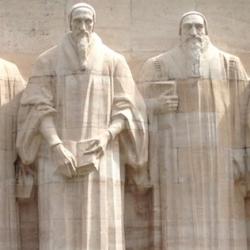In his study of Calvin’s Company of Pastors, Scott Manetsch estimates that “just under 5 percent of all excommunications” in Geneva were imposed because of “Catholic behavior” (203).
By this phrase, he refers to “instances where people voluntarily aligned themselves with some dimension of Roman Catholic faith or practice, such as attending Mass or a Catholic festival, marrying a Catholic spouse, reciting the Ave Maria, fasting from meat on Fridays, fighting in Catholic armies, manufacturing Catholic religious objects, or permitting a priest to baptize or bury members of their families” (203-4).
At times, this Catholic behavior seems to reflect “attachment to traditional religion, s when the wife of Pierre Corajod welcomed a priest into her home and received a rosary from him, or when Collet Dumurgier insisted before the ministers that the Virgin Mary ‘is an advocate for sinners.’” (204). In other cases, the infractions were the result of “familial commitments and commercial interests” that “required ongoing contact with the Catholic world” (204).
At times the Catholic behavior just barely qualifies as “voluntary”: “When Catholics regained control of Lyon in 1567, hundreds of Protestant refugees fled to Geneva, many of whom had temporarily abjured reformed religion or participated in Catholic rites out of fear of persecution. In 1568 alone, the Geneva Consistory suspended 149 French refugees for this sin; the following year another 98 people were censured.” They told stories of being forced to attend Mass at knifepoint, of being threatened with death if they refused to wear a crucifix. After 1569, the Consistory shifted its tactics: “refugees who confessed . . . were not excommunicated from the sacrament as long as they agreed to make public reparation during a Sunday worship service prior to the quarterly Communion service” (204).
The persistence of Catholic piety in reformed churches indicates that “Catholic believe was never completely eradicated from reformed Geneva, especially from the outlying villages in close proximity to Catholic Savoy” (204).














